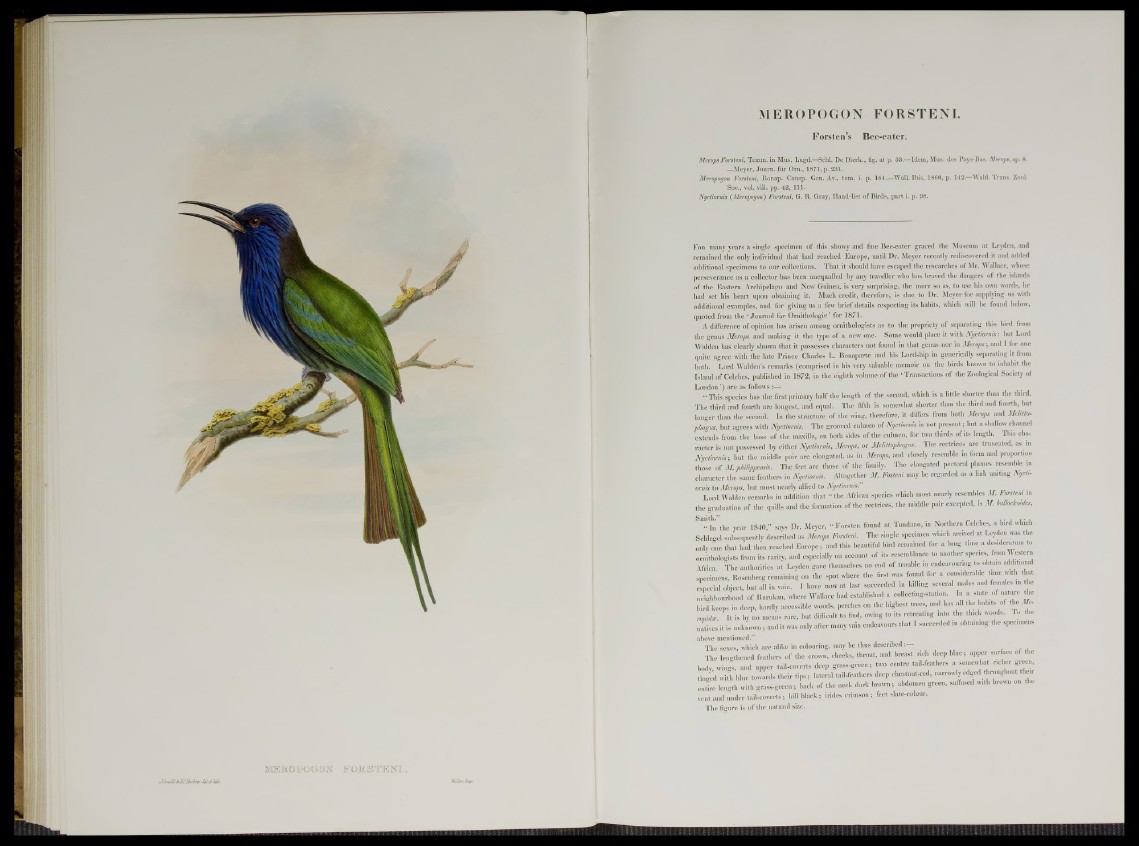
MEROPOGON FORSTENI.
Fo rsten ’s Bee-eater.
Merops Forsteni, Temm. in Mus. Lugd.—Schl. De Dierk., fig. a t p. 53.—Idem, Mus. des Pays-Bas. Merops, sp. 8.
—Meyer, Journ. fur Om., 1871, p. 231.
Meropogon Forsteni, Bonap. Consp. Gen. Ay., tom. i. p. 164.—Wall. Ibis, 1860, p. 142.—Wald. Trans. Zool.
Soc., vol. viii. pp. 42, 111.
Nyctiomis (Meropogon) Forsteni, G. R. Gray, Hand-list of Birds, p art i. p. 98.
F ob many years a single specimen of this showy and fine Bee-eater graced the Museum at Leyden, and
remained the only individual that had reached Europe, until Dr. Meyer recently rediscovered it and added
additional specimens to our collections. That it should have escaped the researches of Mr. Wallace, whose
perseverance as a collector has been unequalled by any traveller who has braved the dangers of the islands
of the Eastern Archipelago and New Guinea, is very surprising, the more so as, to use his own words, he
had set his heart upon obtaining it. Much credit, therefore, is due to Dr. Meyer for supplying us with
additional examples, and for giving us a few brief details respecting its habits, which will be found below,
quoted from the ‘Journal fur Ornithologie ’ for 1871.
A difference of opinion has arisen among ornithologists as to the propriety of separating this bird from
the genus Merops and making it the type of a new one. Some would place it with Nyctiomis: but Lord
Walden has clearly shown that it possesses characters not found in that genus nor in Merops; and I for one
quite agree with the late Prince Charles L. Bonaparte and his Lordship in generically separating it from
both. Lord Walden’s remarks (comprised in his very valuable memoir on the birds known to inhabit the
Island of Celebes, published in 1872, in the eighth volume of the ‘Transactions of the Zoological Society of
London ’) are as follows:—
■' This species has the first primary half the length of the second, which is a little shorter than the third.
The third and fourth are longest, and equal. The fifth is somewhat shorter than the third and fourth, but
longer than the second. In the structure of the wing, therefore, it differs from both Merops and Melitto-
phagus, but agrees with Nyctiorms. The grooved culmen of Nyctiomis is not present; but a shallow channel
extends from the base of the maxilla, on both sides of the culmen, for two thirds of its length. This character
is not possessed by either Nyctiorms, Merops, or Melittophagus. The rectrices are truncated, as in
Nyctiomis; hut the middle pair are elongated, as in Merops, and closely resemble in form and proportion
those of M. phMppensis. The feet are those of the family. The elongated pectoral plumes resemble in
character the same feathers in Nyctiomis. Altogether M. Fosteni may be regarded as a link uniting Nyct,-
ornis to Merops, but most nearly allied to Nyctiomis.”
Lord Walden remarks in addition that “ the African species which most nearly resembles M. Forsteni in
the graduation of the quills and the formation of the rectrices, the middle pair excepted, is M. bullockoides,
the year 1840,” says Dr. Meyer, “ Forsten found at Tondano, in Northern Celebes, a bird wluch
Schlegel subsequently described as Merops Forsteni. The single specimen which arrived at Leyden was the
only one that had then reached Europe; and this beautiful bird remained for a long time a desideratum to
ornithologists from its rarity, and especially on account of its resemblance to another spec.es from Western
Africa. The authorities at Leyden gave themselves no end of trouble in endeavouring to obtain additional
specimens, Rosenberg remaining on the spot where the first was found for a considerable tune with that
especial object, but all in vain. I have now at last succeeded in killing several males and females in the
neighbourhood of Rurukan, where Wallace had established a collecting-station. In a state of nature the
bird keeps in deep, hardly accessible woods, perches on the highest trees, and has all the habits of the Me-
ronidte It is by no means rare, but difficult to find, owing to its retreating into the thick woods. To the
natives it is unknown ; and it was only after many vain endeavours that I succeeded in obtaining the specimens
above mentioned.”
The sexes, which are alike in colouring, may be thus described 9 . . ’ fifeB
The lengthened feathers of the crown, cheeks, throat, and breast rich deep blue; upper surface of the
body, wings, and upper tail-coverts deep grass-green; two centre tail-feathers a somewhat richer green,
tinged with blue towards their tips ; lateral tail-feathers deep chestnut-red, n a r r o w l y edged throughout their
entire length with grass-green ; back of the neck dark brown; abdomen green, suffused with brown on
vent and under tail-coverts; bill black; irides crimson; feet slate-colour.
The figure is of the natural size.